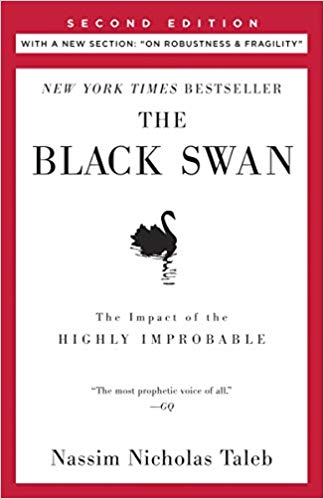

This article is an excerpt from the Shortform summary of "The Black Swan" by Nassim Taleb. Shortform has the world's best summaries of books you should be reading.
Like this article? Sign up for a free trial here .
What is a fractal? How are fractals useful in representing and predicting relatively unpredictable events?
A fractal is a geometric pattern that repeats at different scales. Fractals, unlike pure geometric shapes like triangles or circles, are seen quite frequently in nature.
We’ll cover what a fractal is and how it can help us make predictions in a world full of uncertainty.
What Is a Fractal?
Developed by mathematician Benoît Mandelbrot in the 1970s, “fractals” are Mandelbrot’s coinage for geometric patterns that repeat at different scales. Fractals, unlike pure geometric shapes like triangles or circles, are seen quite frequently in nature. For example, a leaf’s veins look like little branches, and a tree’s branches look like little trees: the basic shape of the tree is echoed at the smaller scales.
So can the phenomena of Extremistan be modeled—and thereby predicted—at all? Not precisely; but they can be approximated—by the use of fractals.
What is a fractal, and how is it useful in predicting unpredictable events? The reason fractals are helpful in representing Black Swans is that their internal ratios stay constant across scales. Unlike bell curves, in which ratios decline at accelerating rates the further one gets from the average, fractals exhibit no (or mild) acceleration. They obey power laws, which describe a functional relationship between two quantities in which the relationship remains constant no matter what the initial size of the quantities.
Take the European wealth example noted just above. As the wealth number doubled, the incidence decreased by 4x (wealth greater than 1 million: 1 in 62.5; wealth greater than 2 million: 1 in 250; wealth greater than 4 million: 1 in 1,000; etc.). The “power” in this relationship is 2, because 2^2 (2 squared) is 4.
Now, imagine the power was 1: Each time the wealth doubled, the incidence would only decrease by 2x (2^1=2). The probability of extraordinary wealth would increase. This helps us understand why fractals are useful and it helps us answer the question, What is a fractal?
For Extremistan phenomena, the power laws aren’t known with any certainty, but they can be approximated. Say, for example, you want to assess the risk of a stock portfolio, and you know that, based on past data, the worst-case scenario is a -5% move once every 2 years. With a power of 2—remember that the power is estimated—you can assume that a -10% move will happen once every 8 years (2^2=4) and a -20 percent move will happen once every 32 years. (For scale, in the 1987 crash, the U.S. stock market lost almost 23% of its value, an impossibility according to Gaussian economic models.) With fractal/power-law distributions, a 1000-year flood can become a 100-year one, and a 100-year one can become a 10-year one.
When we begin to analyze Extremistan in terms of the fractal paradigm, some Black Swans suddenly become “gray”—they’re not predictable with any sort of precision, but they are, at least, imaginable.
What is a fractal? It’s a geometric pattern that repeats at different scales and it’s useful in making predictions in a world of uncertainty.
Fractals and the Limits of the Bell Curve
When answering the question, What is a fractal? it’s useful to understand an alternate way of representing the world. The classic bell curve—which is also called the “Gaussian distribution” after German mathematician Carl Friedrich Gauss—is an accurate description of Mediocristan phenomena, but it is dangerously misleading when it comes to Extremistan.
Consider human height, an eminently Mediocristan phenomenon. With every increase or decrease in height relative to the average, the odds of a person being that tall or short decline. For example, the odds that a person (man or woman) is three inches taller than the average is 1 in 6.3; 7 inches taller, 1 in 44; 11 inches taller, 1 in 740; 14 inches taller, 1 in 32,000.
It’s important to note that the odds not only decline as the height number gets further and further away from the average, but they decline at an accelerating rate. For example, the odds of someone being 7’1” are 1 in 3.5 million, but the odds of someone being just four inches taller are 1 in 1 billion, and the odds of someone being four inches taller than that are 1 in 780 billion! This would phenomena would not be represented by fractals.
Now consider an Extremistan phenomenon like wealth. In Europe, the probability that someone has a net worth higher than 1 million euros is 1 in 62.5; higher than 2 million euros, 1 in 250; higher than 4 million, 1 in 1,000; higher than 8 million, 1 in 4,000; and higher than 16 million, 1 in 16,000. The odds decrease at a constant, rather than accelerating, rate, indicating that their distribution doesn’t conform to a bell curve.
(Note: The European wealth statistics cited above aren’t precise, but they illustrate the central point: that wealth is scalable and does not look like a bell curve.) What is a fractal? A fractal is an important way to represent randomness.
———End of Preview———

Like what you just read? Read the rest of the world's best summary of "Black Swan" at Shortform . Learn the book's critical concepts in 20 minutes or less .
Here's what you'll find in our full Black Swan summary :
- Why world-changing events are unpredictable, and how to deal with them
- Why you can't trust experts, especially the confident ones
- The best investment strategy to take advantage of black swants






